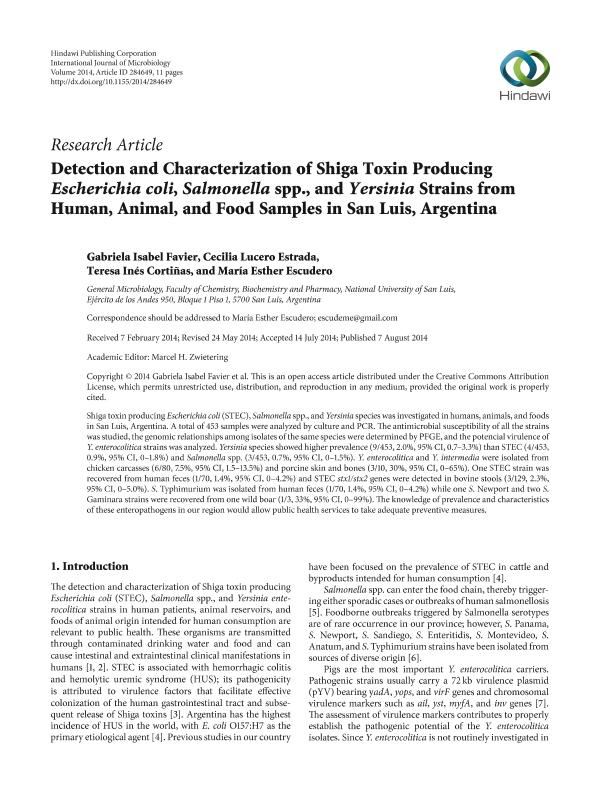Artículo
Detection and characterization of shiga toxin producing Escherichia coli, Salmonella spp., and Yersinia strains from human, animal, and food samples in San Luis, Argentina
Favier, Gabriela Isabel ; Lucero Estrada, Cecilia Stella Marys
; Lucero Estrada, Cecilia Stella Marys ; Cortiñas, Teresa Inés; Escudero, María Esther
; Cortiñas, Teresa Inés; Escudero, María Esther
 ; Lucero Estrada, Cecilia Stella Marys
; Lucero Estrada, Cecilia Stella Marys ; Cortiñas, Teresa Inés; Escudero, María Esther
; Cortiñas, Teresa Inés; Escudero, María Esther
Fecha de publicación:
08/2014
Editorial:
Hindawi Publishing Corporation
Revista:
International Journal of Microbiology
ISSN:
1687-918X
e-ISSN:
1687-9198
Idioma:
Inglés
Tipo de recurso:
Artículo publicado
Clasificación temática:
Resumen
Shiga toxin producing Escherichia coli (STEC), Salmonella spp., and Yersinia species was investigated in humans, animals, and foods in San Luis, Argentina. A total of 453 samples were analyzed by culture and PCR. The antimicrobial susceptibility of all the strains was studied, the genomic relationships among isolates of the same species were determined by PFGE, and the potencial virulence of Y. enterocolitica strains was analyzed. Yersinia species showed higher prevalence (9/453, 2.0%, 95% CI, 0.7–3.3%) than STEC (4/453, 0.9%, 95% CI, 0–1.8%) and Salmonella spp. (3/453, 0.7%, 95% CI, 0–1.5%). Y. enterocolitica and Y. intermedia were isolated from chicken carcasses (6/80, 7.5%, 95% CI, 1.5–13.5%) and porcine skin and bones (3/10, 30%, 95% CI, 0–65%). One STEC strain was recovered from human feces (1/70, 1.4%, 95% CI, 0–4.2%) and STEC stx1/stx2 genes were detected in bovine stools (3/129, 2.3%, 95% CI, 0–5.0%). S. Typhimurium was isolated from human feces (1/70, 1.4%, 95% CI, 0–4.2%) while one S. Newport and two S. Gaminara strains were recovered from one wild boar (1/3, 33%, 95% CI, 0–99%). The knowledge of prevalence and characteristics of these enteropathogens in our region would allow public health services to take adequate preventive measures.
Palabras clave:
Detection
,
Characterization
,
Stec
,
Salmonella
,
Yersinia
,
Food
Archivos asociados
Licencia
Identificadores
Colecciones
Articulos(IMIBIO-SL)
Articulos de INST. MULTIDICIPLINARIO DE INV. BIO. DE SAN LUIS
Articulos de INST. MULTIDICIPLINARIO DE INV. BIO. DE SAN LUIS
Citación
Favier, Gabriela Isabel; Lucero Estrada, Cecilia Stella Marys; Cortiñas, Teresa Inés; Escudero, María Esther; Detection and characterization of shiga toxin producing Escherichia coli, Salmonella spp., and Yersinia strains from human, animal, and food samples in San Luis, Argentina; Hindawi Publishing Corporation; International Journal of Microbiology; 2014; 284649; 8-2014; 1-11
Compartir
Altmétricas



